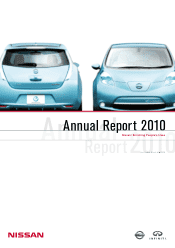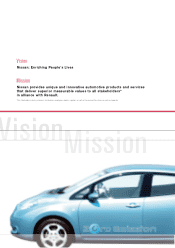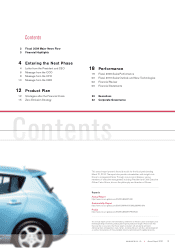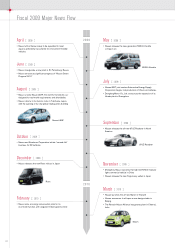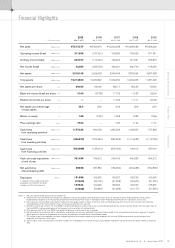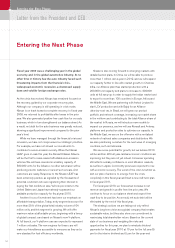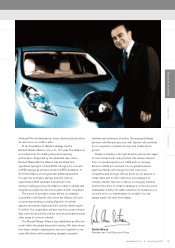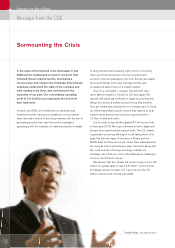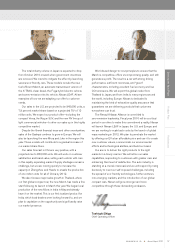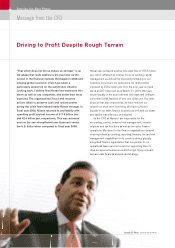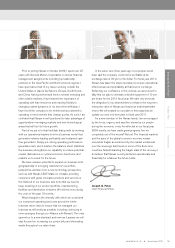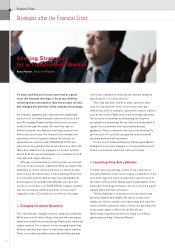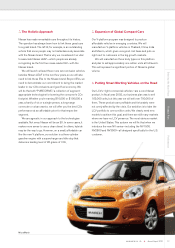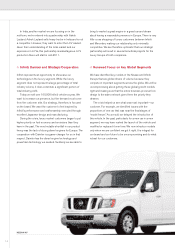Nissan 2010 Annual Report Download - page 6
Download and view the complete annual report
Please find page 6 of the 2010 Nissan annual report below. You can navigate through the pages in the report by either clicking on the pages listed below, or by using the keyword search tool below to find specific information within the annual report.
04
Entering the Next Phase
Letter from the President and CEO
Entering the Next Phase:
Nissan is also moving forward in emerging markets with
detailed action plans. In China, we will be able to produce
more than 1 million cars a year in 2012, and we will expand
our capacity further in line with market growth. In Chennai,
India, our Alliance plant has started production with a
200,000-unit capacity and plans to increase to 400,000
units at full ramp-up in order to supply the Indian market and
to export to more than 100 countries in Europe, Africa and
the Middle East. We are partnering with Ashok Leyland to
start LCV production and with Bajaj for an Alliance
ultra-low-cost car. In Brazil, we will grow our product
portfolio and network coverage, increasing our market share
in the midterm and contributing to the total Alliance share of
the market. In Russia, we will introduce new models to
expand our presence, and we will use Renault and Avtovaz
platforms and production sites to optimize our capacity. In
the Middle East, we are on the offensive with a revitalized
network of national sales companies and distributors. We
are also positioning ourselves for the next wave of emerging
countries, such as Indonesia.
We see some potential for growth, but we believe 2010
will be another difficult year. Global economic conditions are
improving, but they are not yet robust. Consumer spending
still reflects a shaky confidence in most Western markets,
as well as in Japan. Commodity prices are expected to rise
with economic recovery. The worst of the crisis is behind us,
and our plan of action is to emerge from the crisis
completely in this fiscal year and start a new mid-term plan
in fiscal year 2011.
For fiscal year 2010, we forecast an increase in net
revenue and growth in profits from the prior year. We
continue to focus on our balance sheet and expect free
cash flow to be positive. As a result, net auto debt will be
eliminated by the end of this fiscal year.
The strategic actions we are taking not only reflect
Nissan’s long-term vision as a global company that creates
sustainable value, but they also show our commitment to
maximizing total shareholder return. Based on the current
state of our business and weighing the risks and
opportunities for this year, we plan to reinstate dividend
payments for fiscal year 2010 at 10 yen for the full year (5
yen for the interim dividend and 5 yen for the year-end
Fiscal year 2009 was a challenging year in the global
economy and in the global automotive industry. At no
other time in history has the auto industry faced such
threatening impacts from the financial crisis,
widespread economic recession, a distressed supply
base and volatile foreign exchange rates.
As the crisis has evolved, Nissan has remained focused on
the recovery, guided by our corporate recovery plan.
Although our company is still operating in crisis mode,
Nissan is on track toward a complete recovery. In fiscal year
2009, we returned to profitability after losses in the prior
year. We also generated positive free cash flow for our auto
business, which in turn strengthened our balance sheet. As
a result, net debt for the auto business was greatly reduced,
showing a significant improvement compared to the prior
year’s level.
While we have managed through the financial crisis and
recession, we have not compromised our strategic priorities.
For example, we have not slowed our investments to
contribute to a zero-emission society. When the Nissan
LEAF goes on sale this year, the Renault-Nissan Alliance
will be the first to mass-market affordable zero-emission
vehicles. We will have invested in a battery capacity of
500,000 units for the Alliance; no other automaker will be
producing electric batteries or cars at such a scale. And
customers are ready. Response to the Nissan LEAF has
been extremely positive, as signaled by the thousands of
potential customers who are registering their interest in
buying the first models on sale. Vehicle pre-orders in the
United States and Japan have already surpassed our
available production capacity for fiscal year 2010.
Another focus of investment has been our emphasis on
affordable transportation. Today, entry segments account for
more than 25% of the global total industry volume of 64
million units, and this segment is growing. We will offer
maximum value at affordable prices, beginning with a lineup
of global compact cars based on Nissan’s new V-platform.
At full launch, our V-platform cars are expected to represent
1 million unit sales. The new engines for these cars will
make eco-friendliness accessible to everyone as they set a
new standard for fuel efficiency worldwide.

